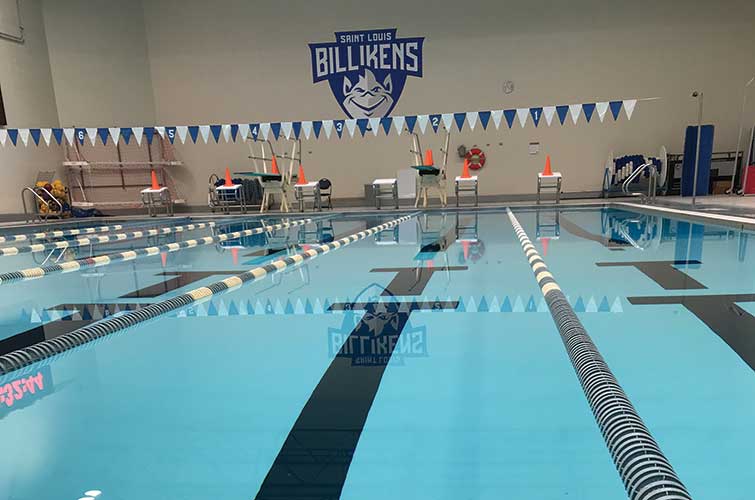Ensuring your aquatics department is following the best risk management protocols is an ongoing task involving not only the safety of patrons in your pools, but also the safety of patrons in and around your aquatics areas. Here, two aquatics professionals share the best practices for keeping these areas safe and clean, locker rooms inclusive, and how to inspire staff to be more passionate about aquatics risk management.
Cleaning Protocols
At Saint Louis University, Emily Wujcik, the aquatics and safety coordinator, said the safety of staff and patrons is first and foremost. This is why one of her best practices includes making sure things are consistently picked up to help prevent tripping and falling.
“We have staff come in every weekday to complete pool maintenance and follow a checklist that includes putting in the pool vacuum, scrubbing the pool deck, wiping down the stainless steel, organizing equipment patrons can borrow and ensuring chair lift batteries are charged,” said Wujcik. “Additionally, all staff in our building carry a digital radio with them in case anything comes up that needs our attention.”
For over two years, Wujcik has worked with Recreonics for aquatics supplies such as guard tubes, backboards, pool vacuums, noodles and more. “They have outstanding customer service and have been extremely helpful over the years,” she said.
Before closing in mid-March due to the coronavirus pandemic, Kate Vanlandingham, the assistant director of aquatics at Tulane University, said her team’s cleaning schedule will most likely change upon reopening. “We had a cleaning schedule for lifeguards to hose and squeegee the pool deck throughout the day, and we did deep disinfecting once a week at closing,” she said. “For our locker rooms, we had a crew who routinely cleaned and sanitized throughout the day with a deep clean each night.”
To assist with the cleaning schedule, head guards at Tulane also incorporate iPads to report chemistry readings and complete checklists in Counsilman Hunsaker’s HydroApps Facility Manager. “We have been using it since the fall of 2018, and it has allowed us to go paperless, hold staff more accountable and generate reports easily,” said Vanlandingham.

Locker Room Inclusivity
Other safety measures in your aquatics areas include making sure locker rooms are safe and inclusive for patrons. At Tulane, five gender inclusive, cabana-style bathrooms are available to patrons, as well as several changing stalls and private showers in the locker rooms.
Saint Louis also provides private, all-gender restrooms and showers made possible through a recent renovation. To ensure these areas are clean and safe for use, Wujcik’s team completes walkthroughs regularly and makes sure items are not left behind. “Additionally, we work with our maintenance crew for fixing items and updating those facilities when it’s appropriate,” she said.
Inspiring Staff
Cleaning can often feel like a chore, especially to student staff. One way Vanlandingham’s team encourages staff to clean and stay on top of risk management protocols is a department-wide program called “Win the Day.”
“With this program, staff earn tokens for completing cleaning tasks, providing proper emergency response, giving good customer service, etc.,” she said. “It encourages them to do a good job to earn rewards. One of our staff’s favorite rewards is free personal training sessions.”
Furthermore, Vanlandingham said education on the why behind every policy or protocol is important. It can give staff a greater feeling of responsibility and understanding of what could happen if proper protocols are not followed.
All in all, Wujcik agreed inspiring staff often comes from a place of understanding and learning. “Working with your staff and asking them to come into the space as a patron with a critical eye, seeing what their views of the facility are, can help them understand some of the risk management we do, help them understand why we clean and how important it is,” she said. “This also helps professional staff continue to update or change how we do things to ensure we are doing our best to mitigate risks within our facility.”










